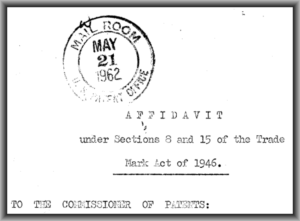Today we received an interesting letter from the post-registration branch at the USPTO. The letter says that the Section 15 papers that we filed a couple of months ago (to make a registration “incontestable“) are being bounced. The Section 15 fee that we paid will be refunded, the letter explains. The letter explains that the Section 15 papers that we filed “remain in the record”. The Section 15 papers “will not be returned to you and will not be processed or reviewed.” Can you guess why this happened?
Well we take as our starting point in this discussion the reminder that for any particular US trademark registration, you can’t make it “incontestable” twice. Once it has been made “inconstestable”, then that’s it, and you can’t (for example) make it twice as incontestable. (What this brings to mind, oddly, is the “double secret probation” of the movie Animal House. But I digress.)
For most US practitioners, you would not expect to encounter a problem of accidentally trying to make something “incontestable” a second time if in fact it was already “incontestable”. One reason for this is that most US practitioners carry out their filings by means of e-filing in TEAS. And TEAS will warn you if you try to make something “incontestable” a second time if it is already “incontestable”. TEAS is programmed in a pretty smart way to look in TSDR to see if a file is already “incontestable”, and if it is, TEAS will warn you that you probably don’t want to proceed. (Kudos by the way to the TEAS designers who did this smart thing.)
So back to the story. A couple of months ago, we received instructions from foreign counsel to carry out a sixty-year renewal of a trademark registration. (Yes, sixty years!) I suggested that the client might wish to make the registration “incontestable” and the client agreed. So we filed the Section 15 papers.
Which brings us back to the starting point for this blog article. The post-registration branch bounced the Section 15 papers.
The letter from the post-reg branch explains that the client filed Section 15 papers back in 1962! And so I went back to TSDR to see if this was true.
Practitioners who have been around a while will recall that it was in about 2006 that the USPTO started a long and slow process of going “paperless” for its trademark files. The USPTO gradually scanned old paper files one by one into TSDR, a process that took many years. In this particular case, the old paper file got scanned into TSDR in 2009. The cardboard file jacket got scanned with a document description of “ file jacket” and the contents of the paper file got scanned with a document description of “unclassified”. And right here you can see on the front page of the file jacket that somebody at the USPTO named John M. Breen n
file jacket” and the contents of the paper file got scanned with a document description of “unclassified”. And right here you can see on the front page of the file jacket that somebody at the USPTO named John M. Breen n oted the filing and acceptance of a Section 15 affidavit. And sure enough, right there in the “unclassified” document we can see the affidavit, part of which is quoted here.
oted the filing and acceptance of a Section 15 affidavit. And sure enough, right there in the “unclassified” document we can see the affidavit, part of which is quoted here.
The alert reader will note, however, that whoever scanned these old paper files in 2009 did not go to the additional step of noting in TSDR that the registration was “incontestable”. Which explains why TEAS did not warn me about this duplicate Section 15 filing.
To the credit of the post-reg branch, somebody actually went to the trouble to look through these old paper scans, and found that the client had already paid the money to get this registration to be incontestable. I’d like to offer kudos to this person, whose initials are “Tamika Whitsey”. Ms. Whitsey saved our client $200. Thank you, Ms. Whitsey! Ms. Whitsey also noted in TSDR that the registration is “incontestable”. So in the future, if someone were to repeat my mistake and try yet again to file Section 15 papers in this case, TEAS would warn this person.
Which brings us to the question “How did we screw up?”
If our firm had been handling this case back in 1962, then of course we would have and should have made a note in our file that we had filed the Section 15 papers. Our firm was not, however, handling this case back in 1962. Our firm was not founded until some thirty years later!
But when we did the file intake for this file (a couple of years ago), loading the case into our docketing systems, I now realize that one thing we should have done was to review the old scans of the paper file. In this file intake review, we would have (hopefully) caught on that the case was already incontestable. We would then have checked the “incontestable” box in the computer docket system, and we would have known not to file another Section 15 filing.
At this point we plan to look through all of our US trademark cases dating from before about 2009 to see if they are “incontestable”. And if they are, we will ask the post-reg branch to note the “incontestable” status in TSDR (if it is not already so noted in TSDR). (And we will note it in our computer docket system.) That way, if someone tries to do a Section 15 filing in TEAS for a file in this category, the TEAS system will generate a warning.
